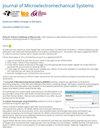低温制造用于医疗植入物的毫米级 MEMS 压电超声波能量收集器
IF 3.1
3区 工程技术
Q2 ENGINEERING, ELECTRICAL & ELECTRONIC
引用次数: 0
摘要
基于微机电系统的压电超声波能量收集器(PUEH)已成为医疗植入物中替代电池或向电池传输能量的最有前途的选择之一,因为医疗植入物需要设备微型化和功率优化。在 PUEH 最常用的压电材料中,锆钛酸铅(PZT)因其优异的压电特性、良好的稳定性和低成本而得到广泛认可。然而,当加工温度接近或超过居里温度(T $_{\mathrm {c}}$ )的一半时,PZT 的性能就会下降,从而限制了其应用。在此,我们展示了一种高度微型化、低温制造的基于 MEMS 的 PUEH,其有效超声波采集面积为 0.79 mm2,有效器件体积为 0.35 mm3。低温环氧树脂粘合剂可确保整个制造过程的温度保持在 85~^{\circ }$ C 以下,从而最大程度地保留了集成压电材料的特性。这样就可以使用大块 PZT-5H(一种具有优异压电特性但 Tc 相对较低的材料)来提高器件性能。在最佳工作频率为 200 kHz、水中接收距离为 20 mm、输入声功率强度为 178 mW/cm2 的条件下,我们的器件在 2 k $\Omega $ 电阻负载上输出 0.62 V 的均方根电压和 0.19 mW 的均方根功率。所提出的设计和制造技术使我们的设备在已报道的基于 MEMS 的 PUEH 中实现了最小的有效尺寸,同时还能为众多植入式医疗设备供电,并与各种市售电源管理单元兼容。[2024-0081]本文章由计算机程序翻译,如有差异,请以英文原文为准。
Low-Temperature Fabrication of Millimeter-Scale MEMS-Based Piezoelectric Ultrasonic Energy Harvesters for Medical Implants
MEMS-based piezoelectric ultrasonic energy harvesters (PUEH) have become one of the most promising options for replacing or transferring energy to batteries in medical implants, where device miniaturization and power optimization are needed. Among the most commonly used piezoelectric materials in PUEH, lead zirconate titanate (PZT) is widely acknowledged for its excellent piezoelectric properties, good stability, and low cost. However, the performance of PZT degrades when the processing temperature approaches and exceeds half of its Curie temperature (T
$_{\mathrm {c}}$
), limiting its application. Here, we demonstrate a highly miniaturized, low-temperature fabricated MEMS-based PUEH with an effective ultrasound harvesting area of 0.79 mm2 and an effective device volume of 0.35 mm3. The low-temperature adhesive epoxy bonding ensures the temperature throughout the entire fabrication process remains below
$85~^{\circ }$
C, which preserves the properties of the integrated piezoelectric material to the greatest extent. This allows the use of bulk PZT-5H, a material that possesses superior piezoelectric properties, but has a relatively low Tc, to enhance device performance. Our device outputs a root-mean-square (RMS) voltage of 0.62 V and an RMS power of 0.19 mW on a 2 k
$\Omega $
resistive load at an optimum operating frequency of 200 kHz, with a reception distance of 20 mm in water and input acoustic power intensity of 178 mW/cm2. The proposed design and fabrication technique enable our device to achieve the smallest effective size among the reported MEMS-based PUEH while still being capable of powering up numerous implantable medical devices and being compatible with various commercially available power management units. [2024-0081]
求助全文
通过发布文献求助,成功后即可免费获取论文全文。
去求助
来源期刊

Journal of Microelectromechanical Systems
工程技术-工程:电子与电气
CiteScore
6.20
自引率
7.40%
发文量
115
审稿时长
7.5 months
期刊介绍:
The topics of interest include, but are not limited to: devices ranging in size from microns to millimeters, IC-compatible fabrication techniques, other fabrication techniques, measurement of micro phenomena, theoretical results, new materials and designs, micro actuators, micro robots, micro batteries, bearings, wear, reliability, electrical interconnections, micro telemanipulation, and standards appropriate to MEMS. Application examples and application oriented devices in fluidics, optics, bio-medical engineering, etc., are also of central interest.
 求助内容:
求助内容: 应助结果提醒方式:
应助结果提醒方式:


